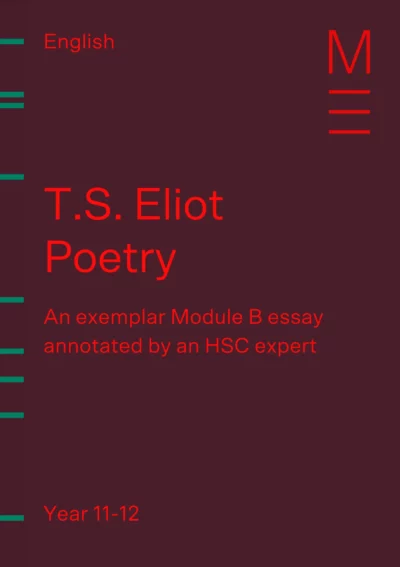Welcome to Matrix Education
To ensure we are showing you the most relevant content, please select your location below.
Select a year to see courses
Learn online or on-campus during the term or school holidays
Learn online or on-campus during the term or school holidays
Learn online or on-campus during the term or school holidays
Learn online or on-campus during the term or school holidays
Learn online or on-campus during the term or school holidays
Learn online or on-campus during the term or school holidays
Learn online or on-campus during the term or school holidays
Get HSC Trial exam ready in just a week
Get HSC exam ready in just a week
Select a year to see available courses
Science guides to help you get ahead
Science guides to help you get ahead
The best preparation for Module B is practice essays. In this article, we've put together 3 questions for each text to help you ace your Paper 2 exam!

Join 75,893 students who already have a head start.
"*" indicates required fields
You might also like
Related courses

Join 8000+ students each term who already have a head start on their school academic journey.
Do you need help refining your Module B writing? The best preparation is answering Module B practice essay questions. Fortunately for you, we have 31 questions here for you to practice on (3 for each prescribed text!)
Remember, Module B is all about critical thinking.
This means that you have to make a judgement and evaluate the composer’s use of technique, form and style to convey meaning.
In this Module, you can be asked 3 different types questions in your HSC English exams.
These are:
So, to prepare you for your HSC exams, we will provide you with a variety of essay questions.
Emma is a revolutionary novel that gave women a voice.
In your response, evaluate how Austen’s distinctive narrative style challenges or affirms this view.
In your response, focus on key episodes in the novel.
Great Expectations relies on humour to evoke uncommon response from the audience.
To what extent does the above statement align with your understanding of Charles Dickens’ Great Expectation.
In your response, focus on key episodes in the novel.
An Artist of the Floating World is told by an unreliable narrator who seeks comfort.
Write an extended response in which you challenge or affirm this view with close references to Kazuo Ishiguro’s An Artist of the Floating World.
TS Eliot’s unique voice forces his audience to recognise the fragility of the human psyche.
To what extent is the above statement true to T S Eliot: Selected Poems. In your responses, refer to at least TWO of his poems.
See exactly why HSC markers would score this essay highly! Fill out your details below to get this resource emailed to you. "*" indicates required fields
Download your annotated Module B: T.S. Eliot essay

Download your annotated Module B: T.S. Eliot essay
Malouf’s poetry is a journey of unexpected turns that are surprisingly pleasant.
Evaluate how Malouf challenges the audience’s expectations through his use of vivid imagery in Earth Hour.
In your responses, refer to at least TWO of his poems.
Nothing is ever black or white. The world is grey.
In your responses, evaluate how Ibsen’s characters challenge or affirm this statement.
In your response make detailed reference to Ibsen’s play.
Thomas captures the hearts of his audience through his simultaneously rich and hallucinatory language.
To what extent is the above statement true in accordance to your reading of Under Milk Wood.
De Waal’s personal tone in The Hare with Amber Eyes compels audiences to find the rainbow in a storm.
To what extent is the above statement true?
In your response, evaluate how de Waal explores the intricacies of human lives and make close references to The Hare with Amber Eyes.
Nabokov relies heavily on strong rhetorical devices to accurately capture his stream of conscious thoughts.
To what extent do you agree with this statement?
In your responses, evaluate how Vladimir moves his audience emotionally and intellectually.
Clooney uses evocative metaphors to explore the interplay between public and private lives.
With reference to the above statement, evaluate how Clooney’s metaphors motivate his audience to search for their own truths.
In your response, make close references to key episodes in the film.
Armstrong unfolds Florence’s life, but never wraps her back up.
Evaluate the above statement and explore how Armstrong’s unconventional film draws audiences attentions and motivate a search for identity.
In your response, make close reference to key episodes in the film.
Shakespeare’s use of rhetoric is representative of his comments on power and authority.
In your response, evaluate the above statement with close reference to key episodes in the drama.
At Matrix, our insightful resources and expert teaching will help develop your essay writing skills, perfect for Module B.
Learn how to write Band 6 HSC responses in English
Expert HSC teachers, detailed feedback, and comprehensive resources. Learn with Matrix+ online English courses.
“One half of the world cannot understand the pleasures of the other.” – Emma Woodhouse
Evaluate Austen’s use of illusion to reveal the confrontational truth about her society.
In your responses, refer to the quotation and your understanding of the novel.
“We changed again, and yet again, and it was now too late and too far to go back, and I went on. And the mists had all solemnly risen now, and the world lay spread before me.”
Drawing ideas from the above quote, evaluate how Dicken’s narrative style helps convey meaning.
In your response, refer to the above quotation and make detailed references to the novel.
“When you are young, there are many things which appear dull and lifeless. But as you get older, you will find these are the very things that are most important to you.” – Kazuo Ishiguro
Drawing ideas from the above quote, discuss how Ishiguro uses metaphors to explore conflicts in An Artist of the Floating World.
In your response, refer to the above quotation and make detailed references to Ishiguro’s novel.
“Our dried voices, when
We whisper together
Are quiet and meaningless”
– The Hollow Men
Evaluate how Eliot uses religion in his poetry to explore connections and conflicts.
In your response, use the above quote as a starting point and refer to at least 2 of Eliot’s poems.
‘Shy gifts that come to us from a world that may not
Even know that we are here. Windfalls, scantlings.’
Drawing ideas from the above quote, evaluate how Malouf’s powerful rhetoric forces audiences to glimpse at the beauty of dailiness.
In your response, refer to at least 2 poems from Malouf’s Earth Hour.
“To be able to be free from care, quite free from care; to be able to play and romp with the children; to be able to keep the house beautifully and have everything just as Torvald likes it!” – Nora (Act 1)
Evaluate how Ibsen’s complex narrative explores ideas in the above statement to confront his audience.
In your responses, make close references to Ibsen’s play and the above quotation.
“FIRST VOICE: Like a Cat he sees in the dark. Through the voyages of his tears he sails to see the dead.
CAPTAIN VAT: Dancing Williams!
FIRST DROWNED: Still dancing.
CAPTAIN CAT: Jonah Jarvis.
THIRD DROWNED: Still.”
Drawing ideas from the above extract, how does Thomas use humour and voice to convey meaning.
In your responses, make close references to key episodes from the play.
“There is a breath of hesitancy before touching or not touching, a strange moment. If I choose to pick up this small white cup with its single chip near the handle, will it figure in my life?” – De Waal
Evaluate how de Waal uses symbols in his non-fiction text to represent how Earth is a tapestry of interwoven stories.
In your response, draw ideas from the above statement and make close references to The Hare with Amber Eyes.
“Sleep is the most moronic fraternity in the world, with the heaviest dues and the crudest rituals. It is a mental torture I find debasing… I simply cannot get used to the nightly betrayal of reason, humanity, genius.” – Nabokov
Evaluate how Vladimir’s unique writing style represents his thoughts about time and space.
In your responses, use the above statement and make close references to the text.
“Murrow: You were always yellow
Fred: Better than red”
Evaluate how Clooney uses evocative imagery to explore the power of representation in society. Use the above extract as a starting point.
In your response, make detailed reference to the film.
“‘Who are all these people talking about me?” – Florence Broadhurst.
In your response, evaluate how Armstrong’s manipulation of film conventions highlight colourful events, whilst hiding darker truths.
In your response, make detailed reference to the film.
“EARL OF DOUGLAS:
I fear thou art another counterfeit;
And yet, in faith, thou bear’st thee like a king:
But mine I’m sure thou art, whoe’er thou be,
And thus I win thee.”
Drawing ideas from the above statement, evaluate Shakespeare’s commentary on the ideal leader.
In your response, make detailed reference to the play and the above quotation.
Strong prose fiction creates alternate worlds that mirror ours in order to reveal hard truths.
To what extent does the above statement relate to your understanding of your prescribed text.
In your response, make detailed reference to your prescribed novel.
Evocative poetry not only captures the composer’s thoughts and emotions, but it also invites the audience to explore their own thoughts and emotions.
Evaluate the extent to which the above statement is true in accordance to your prescribed text.
In your response, make detailed reference to your prescribed poems.
Good dramas move their audience by portraying reality in a unique way.
In your responses, evaluate whether your prescribed text affirms or challenges the above statement. Make close references to your composer’s distinctive rhetoric.
Non-fiction texts reflect on mundane aspects of life to generate a strong reaction from the audience.
To what extent is the above statement true to your prescribed text.
In your response, evaluate how the composer’s personal tone and voice help them convey meaning with close references to the above statement and your prescribed text.
Powerful films challenge audiences to recognise the uncomfortably profound truths of the world.
To what extent is the above statement true of your prescribed text.
In your response, make detailed reference to your prescribed film.
Unconventional media not only surprise audiences, but draw them in on a roller coaster ride of self-reflection.
Evaluate the above statement with close references to your prescribed text.
Shakespearean dramas are mirrors to our human flaws and social issues.
To what extent is the above statement true to your prescribed text. In your response, make detailed reference to your prescribed play.
Written by Matrix English Team
The Matrix English Team are tutors and teachers with a passion for English and a dedication to seeing Matrix Students achieving their academic goals.© Matrix Education and www.matrix.edu.au, 2025. Unauthorised use and/or duplication of this material without express and written permission from this site’s author and/or owner is strictly prohibited. Excerpts and links may be used, provided that full and clear credit is given to Matrix Education and www.matrix.edu.au with appropriate and specific direction to the original content.